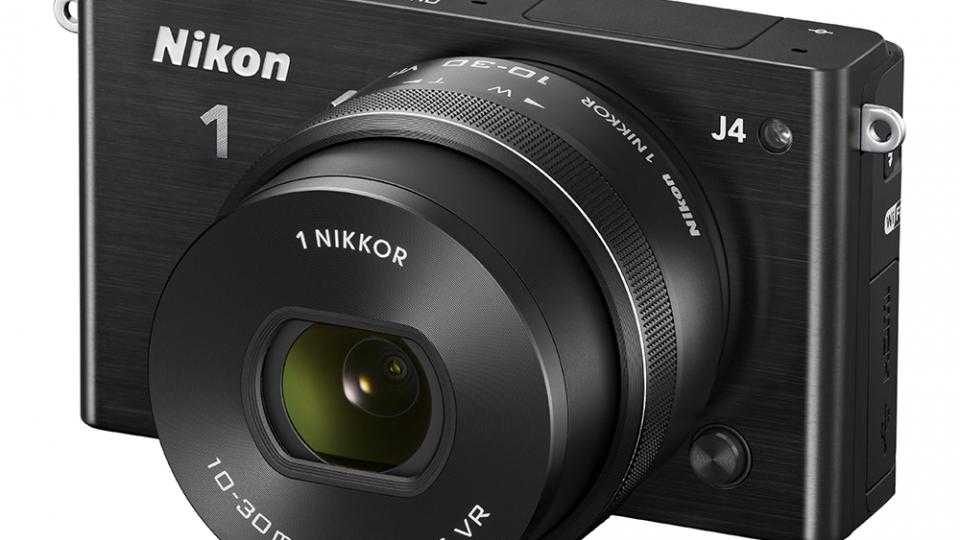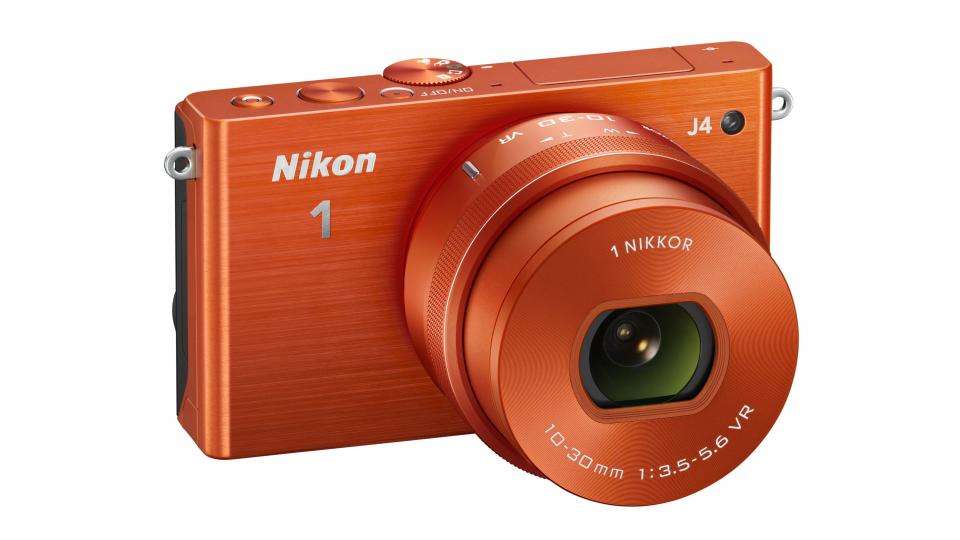The Nikon J4 sits in the middle of the Nikon 1 range of compact system cameras (CSCs). Even in the varied world of CSCs, these cameras stand out with their relatively small 1in sensors, spectacularly fast continuous performance and unconventional operation. As with its predecessors, the J4's mode dial includes various quirky shooting modes, and relegates conventional priority and manual exposure modes to a submenu. The stylish metal body with a choice of black, silver, white or orange finishes confirm that this is no run-of-the-mill camera.
The 1in sensor has about half the surface area of Panasonic and Olympus Micro Four Thirds sensors, and a third that of ACS-C sensors used in Sony, Fujifilm and Samsung CSCs. Smaller sensors tend to exhibit higher noise levels, but they also help to keep the overall size of the camera down. It's something that Nikon is clearly keen to exploit, with a move to a MicroSDXC card slot and Micro HDMI port. Every little helps in the quest for miniaturisation, and the J4 is certainly small for a CSC. However, it's 31g heavier than the J3 that it replaces. It's also 28g heavier than the Panasonic GM1 , our favourite tiny CSC to date.
Wi-Fi is built in, providing transfers to iOS and Android devices. Photos are resized to 1.5MB JPEGs before transfer, and this works for RAW images too. There's a remote viewfinder mode, but control is limited to the shutter release and self-timer only. The app worked flawlessly with a third-generation iPad and Lenovo Android tablet, but we couldn't get it to work with a Nexus 4 Android phone, as the Wi-Fi connection repeatedly dropped a split second after connecting.

The J4's kit lens is quite a departure to the lenses bundled with previous models. It has a motorised zoom function and integrated lens cap, making it feel more like a compact camera than a CSC lens. It's also remarkably slim and light, but still includes a 3x zoom and optical stabilisation. Previous Nikon 1 kit lenses weren't much bigger but they had to be manually retracted and extended before use, which felt a bit clumsy.
The motorised zoom was a little slow to react but it responded appropriately to slow and fast twists. It's a shame there's no zoom lever around the shutter button, as this would have felt more natural for people upgrading from compact cameras, and would have made zooming much easier during video capture. There's no manual focus ring on the lens, so manual focus is adjusted via the wheel on the back of the camera – not a great solution.
Then again, fast autofocus is another key selling point of the Nikon 1 series. The J4 has 105 phase-detect autofocus points built into its sensor, and can shoot at 20fps with continuous autofocus. This is in a different league to any other brand of CSC. It didn't track subjects with rock solid reliability, but on balance we'd say that it delivered on its promises.
Whether this is a useful feature is another matter, though. Subjects must be moving extremely quickly to warrant such a fast burst, so it's likely they'll wander out of the frame rather than out of focus. This mode lasts for 20 frames, whereupon the camera took about 15 seconds to save them all, or 50 seconds for RAW format. We're be more inclined to use the 10fps or 5fps modes, which are likely to give a more varied choice of photos. If you don't need continuous autofocus, burst shooting goes all the way up to 60fps. It's hard to know when this would be useful, especially as it's all over after 20 frames, or a third of a second.
Considering how fast the J4 is able to focus, its performance in normal use is disappointing. It took between 0.4 and one second from pressing the shutter button to capturing a photo, and anything from 1.2 to two seconds between shots. When we pressed the shutter button too quickly after capturing a shot, it ignores the request altogether. Flash photography was quick, though, at 1.7 seconds between shots at full flash power.
There are some interesting options on the mode dial. Motion Snapshot captures a short slow motion video and a photo, and plays them back on the camera complete with saccharine music. You just get the individual files after copying to a computer, though, and the whole thing seems quite frivolous. Best Moment Capture captures 20 frames at either 20fps or 60fps, and then either you or the camera chooses which one to keep. It can even capture pictures from before the shutter button was fully pressed; it starts buffering frames as soon as the button is half pressed. It's an interesting idea, but we'd prefer to be able to rattle off shots at a faster rate in Automatic mode.
Auto mode is as its name suggests, although we like how aperture and shutter speed controls have been renamed Background Softening and Motion Control. Creative mode unlocks a more conventional set of controls, including priority and manual exposure modes. Access to key functions is much improved with the introduction of a touchscreen. Exposure-related settings are adjusted by touching the readouts at the bottom of the screen and spinning the rear wheel. Pressing the F button reveals on-screen controls for exposure mode, autofocus mode, metering mode, colour preset and white balance.
The touchscreen is also used to move the autofocus point, but only after enabling this function by pressing the OK button – and then waiting for half a second while the camera readies itself for the incoming finger prod. Once again, press too early and the camera simply ignores the request. Alternatively, enabling the Touch Shutter mode and touching the screen moves the autofocus point, focuses and takes a picture. It's not our preferred way of taking photos but it's undeniably efficient.
1080p video recording is possible in Auto and Creative modes, but Advanced Movie mode unlocks various additional controls including manual exposure and slow motion capture. There are three slow motion settings ranging from 720p at 120fps to a letterbox-sized 416x144 pixels at 1,200fps. Each one records for just three seconds, so you'll need to time your recordings carefully.
A much more useful feature is the ability to capture up to 20 photos while simultaneously recording 1080p video. These photos are at the full 18-megapixel resolution, and not simply up-scaled 1080p video frames, as some cameras do. Videos exhibited smooth details and flattering colours, although they couldn't match the Panasonic GM1 for precise details.

